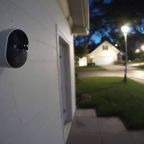Are you wondering if your Ring cameras can still do their job when your Wi-Fi is down? It’s no secret that these smart home devices depend on internet connectivity to function optimally.
This article dives into the capabilities of Ring cameras without Wi-Fi and explores alternative solutions for maintaining security. Keep reading to uncover the potential of your home security system, even in the face of connectivity challenges.
Let’s get connected!
Key Takeaways
- Ring cameras need Wi-Fi to use all their features like live streaming, cloud storage, and receiving real-time alerts on the Ring app.
- If Wi-Fi goes out, some Ring models can record locally if they have that capability but can’t provide real-time updates or stream video.
- Power over Ethernet (PoE) options in certain Ring Elite models offer more reliable connections than Wi-Fi because they get power and internet through an ethernet cable.
- A cellular backup is available for continuous monitoring through services like Ring Alarm Pro with a subscription, using 4G instead of Wi-Fi during outages.
- Local storage options like Ring Edge allow for saving videos directly on devices using MicroSD cards even when there’s no internet connection.
Understanding Ring Cameras and Wi-Fi Dependency
Ring cameras are designed to depend on Wi-Fi connectivity to harness their full suite of features, from live streaming to instant alerts. Diving into how these devices operate can unveil the extent of their functionality without an internet connection and expose potential workarounds for maintaining security vigilance offline.
Watch the following video to learn how to set up a Ring Security System without a constant internet connection. It provides valuable insights into using the Ring system in remote locations or situations where Wi-Fi isn’t available.
Role of Internet Connectivity in Ring Devices
Internet connectivity is the backbone of Ring devices, enabling them to perform a range of functions essential for home security. Without an active connection, cameras and doorbells can’t send video footage to the cloud or receive commands from users through the Ring app.
This connection also allows devices to communicate with each other, creating a networked security system that operates seamlessly. Real-time notifications, which alert homeowners of any activity detected by their Ring cameras, depend entirely on Wi-Fi availability.
Maintaining a stable Wi-Fi network is crucial since these security cameras rely on it not just for live streaming but also for recording events on cloud storage. The strength and reliability of your internet connection dictate the performance and responsiveness of your device.
For instance, motion detection quickly sends alerts to your smartphone via the internet so you can react promptly to any potential threats. With no access to this lifeline, features like remote access are disabled, leaving homes without the proactive defense that smart security systems promise to provide.
Setup Without Wi-Fi: Feasibility and Challenges
Setting up a Ring camera without Wi-Fi presents unique challenges that many users may not anticipate. These devices are designed to rely on a steady wireless connection to link with the cloud, enabling features like live streaming and remote access.
Without Wi-Fi, users might struggle to access real-time notifications or footage from their Ring devices. This limitation greatly affects the core functionality that homeowners value for security and convenience.
Despite these hurdles, it’s technically possible to initiate a Ring camera setup offline; however, this comes with several caveats. A temporary mobile hotspot can serve as an alternative during setup but is not ideal due to potential data caps and less reliable connections compared to traditional Wi-Fi networks.
Users also risk missing critical alerts since the device cannot send updates without online connectivity—compromising its effectiveness as a surveillance tool and home security feature.
Impact of Wi-Fi Outage on Ring Cameras
When a Wi-Fi outage strikes, Ring Cameras’ capabilities can be significantly impacted, leaving homeowners questioning their devices’ security and functionality. Understanding how these smart cameras operate during connectivity disruptions becomes crucial for maintaining home safety and managing expectations.
Are you encountering Wi-Fi connectivity issues with your Ring device? The video below guides you through common troubleshooting steps to keep your Ring devices connected and fully functional.
Functionality During Wi-Fi Outage
Once a Wi-Fi outage occurs, Ring cameras lose the ability to send video footage and alerts. Due to the disconnection from the network, users will not get real-time notifications on their devices.
If the camera has that capability, it essentially becomes a local recording tool, but without internet access, you can’t view live streams or check stored videos remotely.
Ring Chime also depends on a stable Wi-Fi connection; therefore, it won’t function as designed during an outage. Alerts generated by motion detectors or doorbell presses will fail to trigger your Ring Chime, disrupting the seamless smart home experience.
For continuous protection, consider adding cellular backup through services like Ring Alarm Pro with a Ring Protect Pro subscription. This subscription utilizes 4G mobile data as an alternative when your wireless connections are down.
Effect on Ring Chime
Ring Chime units rely heavily on Wi-Fi to function correctly. Without a stable internet connection, the elegant chimes that announce visitors or alert you to motion detected by your Ring cameras fall silent.
In essence, the lack of Wi-Fi transforms your modern notification system into a mere ornament. You’ll miss out on real-time alerts since the device won’t be able to communicate with any of your Ring equipment.
This hiccup in connectivity means no chiming melody will echo through your home when someone presses your doorbell.
To work around this issue, some users opt for mobile hotspots as an interim fix; however, such solutions can’t match the stability offered by a dedicated Wi-Fi network. Expect interruptions: they’re inevitable with less reliable sources like hotspots.
The chime’s functionality is paramount in ensuring you’re notified promptly—be it deliveries at unusual hours or unexpected guests—and maintaining that Wi-Fi connection preserves its role as a critical component of your home security ecosystem.
Recovery of Ring Cameras After Wi-Fi Restoration
Once your home network recovers from a Wi-Fi outage, Ring cameras seamlessly reconnect. They pick up the duty of safeguarding your abode without missing a beat, syncing back with Ring servers to ensure continuous security coverage.
Your device’s ability to instantly spring back into action reflects its design for reliability and user convenience.
Rest assured that all camera functionalities, including live streaming and motion alerts, are swiftly restored. If you’ve set up recording features, they’ll resume capturing every critical moment around your property.
The transition happens in the background; there’s no need for manual reconnection or troubleshooting steps on your part—just uninterrupted vigilance from your trusted wireless security sentinel.
Are you encountering Wi-Fi connectivity issues with your Ring device? The video below guides you through common troubleshooting steps to keep your Ring devices connected and fully functional.
Exploring Cellular Backup and Local Storage Options
Ring Alarm Pro systems ensure continuous protection by implementing a cellular backup solution. If your home’s internet connection goes down, the system seamlessly switches to a 4G mobile data network.
This means that even during an outage, you can rest assured that your property remains monitored and secure. Ring Protect Pro subscribers gain access to this feature, maintaining their peace of mind that security won’t lapse due to connectivity issues.
For those concerned about video storage without Wi-Fi, Ring provides an answer with Ring Edge. Users can store videos locally using MicroSD cards on compatible devices like the Ring Alarm Pro.
This local storage bypasses the need for cloud uploads and keeps critical footage accessible on-site. With end-to-end encryption, these recordings are not only stored securely but also remain private for added security assurance in your smart home ecosystem.
Insight into Ring Elite Models: Operation Without Wi-Fi
Discover the autonomy of Ring Elite models that leverage Power over Ethernet technology, ensuring consistent security and connectivity even when the Wi-Fi lets you down. Find out how these devices redefine reliability in our detailed exploration.
Power over Ethernet (PoE) Technology
Power over Ethernet, or PoE technology, breathes life into Ring Elite models like the Video Doorbell Elite and Stick Up Cam Elite without a Wi-Fi connection. This advanced feature enables these devices to receive both power and data through a single ethernet cable.
It simplifies installation and ensures that even if your wireless internet connection fails, your security isn’t compromised.
Ring’s use of PoE technology underscores its commitment to reliability in smart home security. An ethernet connection provides a steady power supply and consistent internet connections for these devices.
Your Ring camera stays fully operational, keeping an unblinking eye on your home while recording every moment with clarity. Users can rest easy knowing their property is monitored around the clock by a device that won’t be easily disrupted by common Wi-Fi issues.
Communication and Cloud Upload without Wi-Fi
Ring Doorbell Elite and Stick Up Cam Elite models break the mold by offering an alternative to Wi-Fi dependence. They harness Power Over Ethernet (PoE) technology, allowing them to draw power through an ethernet cable and transmit data.
This wired connection provides a stable link for communication and cloud uploads, sidestepping the typical requirement for wireless internet connections. Users enjoy continuous operation and fewer interruptions, thanks to this hardwired setup that offers both electricity and internet in one.
Cloud storage access remains uninterrupted as these models seamlessly sync with Ring’s cloud servers over a wired Ethernet connection. Your cameras keep recording and sending footage directly to the cloud, so you can review any event later without needing a Wi-Fi network.
This robust connectivity ensures your home security system remains active round-the-clock, capturing high-definition video even when traditional wireless networks fail or are unavailable.
Use of Ring Cameras with a Mobile Hotspot
Pairing your Ring cameras with a mobile hotspot can keep the devices humming when regular Wi-Fi isn’t an option. It’s straightforward: Just connect your camera to the hotspot as you would with any other Wi-Fi network.
Be mindful though, data usage might spike, especially if your camera frequently records or streams video.
Mobile hotspots are versatile, but remember, they often have data limits and can suffer from network congestion. You may notice differences in upload speed compared to a traditional home internet setup.
If you go this route, check your plan to avoid unexpected charges and ensure that your mobile provider offers adequate coverage for reliable streaming and notifications from your Ring devices.

Troubleshooting Wi-Fi Issues with Your Ring Cameras
Encountering Wi-Fi problems with your Ring cameras can be a roadblock to maintaining home security. Our guide provides essential steps to diagnose and resolve connectivity issues, ensuring your surveillance system remains a robust guardian against intruders.
Restarting the Router and Camera
If your Ring cameras drop their Wi-Fi connection, restarting the router and camera often fixes the problem. This simple step can refresh your network and clear any temporary glitches that may have caused the disconnection.
To restart your router, unplug it from its power source for about one minute before plugging it back in. As for the camera, press and hold its setup button until it turns off, then release it and allow it to power back up.
Keep an eye on both devices as they reboot; typically, lights or indicators will signal when they are operational again. Once restarted, Ring devices usually successfully reconnect to cloud services without further hassles.
This recovery method is a quick way to resolve many Wi-Fi issues that cause frustration with smart home platforms like Ring video doorbells.
Updating the Camera Firmware
Keeping your Ring camera’s firmware up to date is crucial for maintaining its performance and security. The process is typically straightforward: your camera should automatically download and install firmware updates when it’s connected to Wi-Fi.
These updates bring new features, bug fixes, and enhancements that help your device stay secure against potential threats. Without these updates, you might miss out on improvements or be vulnerable to issues that have been resolved in newer versions.
To manually update the camera’s firmware, access the settings through the Ring app on your smartphone or tablet. You’ll find the option under ‘Device Health.’ The app will guide you through any available updates, which are sent over the air using a secured internet connection.
Ensure your device stays powered during this time; interruptions could cause glitches or incomplete installations. Regular checks for new releases can keep your camera running smoothly and enable it to respond accurately with real-time alerts and clear video footage while providing an extra layer of protection for everything you value at home.
Checking for Voltage Issues
Voltage problems can cause your Ring camera to malfunction or not power on at all. Start by checking the power source. For battery-powered units, ensure the battery is fully charged and properly seated.
If your device is connected via a power adapter, verify that the outlet supplies electricity and the adapter isn’t damaged. Sometimes, fluctuating voltage levels are to blame; this can stem from issues with your home’s electrical wiring or external factors affecting local power.
To further investigate voltage concerns with hardwired Ring cameras, you might use a multimeter tool to measure output directly from the wiring. This step reveals whether there’s consistent voltage available for your camera’s optimal performance.
If readings are irregular or too low, consider consulting an electrician to examine household circuits or replace faulty transformers, ensuring the continuous function of your security system without hitches caused by insufficient voltage supply.
Conclusion
Ring cameras integrate seamlessly into your smart home setup, but they do need that Wi-Fi connection to flex their full capabilities if you find yourself without internet or are dealing with a spotty connection, options like cellular backup and local storage come to the rescue.
Keep in mind, though, that full functionality blossoms only when connected to a strong Wi-Fi network. So, while there’s some wiggle room without it, Wi-Fi is the lifeblood of your Ring device’s top performance.
Rest assured, once your connection zips back to life, so will your Ring camera’s vigilant watch over your home.
FAQ
Ring cameras rely on a Wi-Fi connection to transmit video footage in real-time and for features like facial recognition, but some functions may be available offline.
In case of downtime or interference with your Wi-Fi, Ring cameras cannot send you live feeds, but they may continue to operate on a limited basis, such as recording to backups in the cloud if enabled.
While smartphones and devices like Amazon Echo enhance user experience with voice control, you can’t actively manage your Ring camera without them unless it is connected to another network-enabled device.
Smart locks and other systems integrated with your CCTV require a wireless technology network connection, such as WPA3-secured Wi-Fi or compatible cellular service from carriers such as Verizon or T-Mobile, for full functionality alongside your ring system.
Without an active Wi-Fi connection facilitated by services from providers like U.S Cellular or Xfinity Mobile, certain safety features, such as immediate alerts from carbon monoxide alarms or distress signals via panic buttons, won’t be transmitted in real-time.






